Criminal law Assignment | Human Law
VerifiedAdded on 2022/08/01
|5
|1243
|21
AI Summary
International convention on the elimination of all forms of racial discrimination (ICERD)
Contribute Materials
Your contribution can guide someone’s learning journey. Share your
documents today.
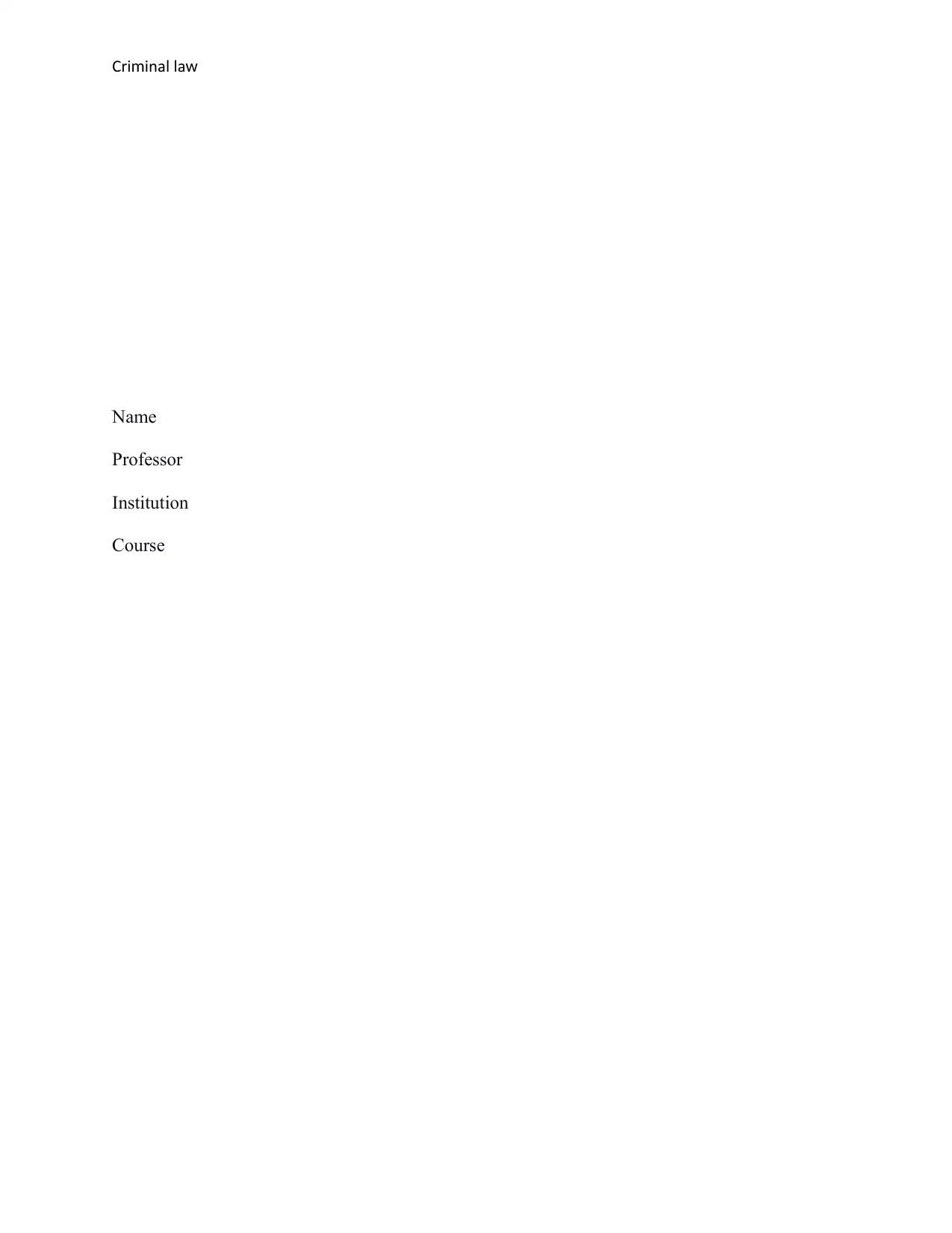
Cri inal lam w
Name
Professor
Institution
Course
Name
Professor
Institution
Course
Secure Best Marks with AI Grader
Need help grading? Try our AI Grader for instant feedback on your assignments.
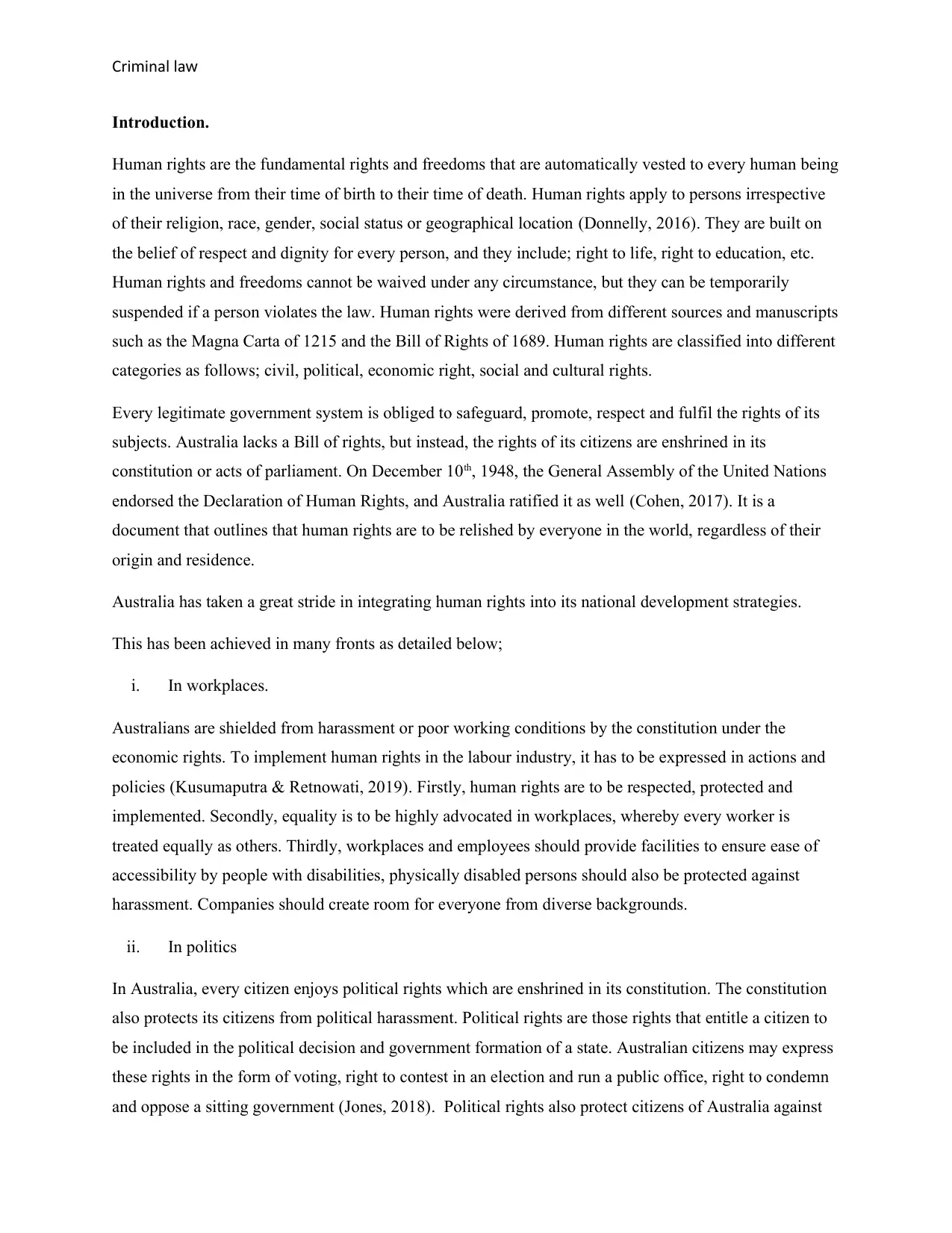
Cri inal lam w
Introduction.
Human rights are the fundamental rights and freedoms that are automatically vested to every human being
in the universe from their time of birth to their time of death. Human rights apply to persons irrespective
of their religion, race, gender, social status or geographical location (Donnelly, 2016). They are built on
the belief of respect and dignity for every person, and they include; right to life, right to education, etc.
Human rights and freedoms cannot be waived under any circumstance, but they can be temporarily
suspended if a person violates the law. Human rights were derived from different sources and manuscripts
such as the Magna Carta of 1215 and the Bill of Rights of 1689. Human rights are classified into different
categories as follows; civil, political, economic right, social and cultural rights.
Every legitimate government system is obliged to safeguard, promote, respect and fulfil the rights of its
subjects. Australia lacks a Bill of rights, but instead, the rights of its citizens are enshrined in its
constitution or acts of parliament. On December 10th, 1948, the General Assembly of the United Nations
endorsed the Declaration of Human Rights, and Australia ratified it as well (Cohen, 2017). It is a
document that outlines that human rights are to be relished by everyone in the world, regardless of their
origin and residence.
Australia has taken a great stride in integrating human rights into its national development strategies.
This has been achieved in many fronts as detailed below;
i. In workplaces.
Australians are shielded from harassment or poor working conditions by the constitution under the
economic rights. To implement human rights in the labour industry, it has to be expressed in actions and
policies (Kusumaputra & Retnowati, 2019). Firstly, human rights are to be respected, protected and
implemented. Secondly, equality is to be highly advocated in workplaces, whereby every worker is
treated equally as others. Thirdly, workplaces and employees should provide facilities to ensure ease of
accessibility by people with disabilities, physically disabled persons should also be protected against
harassment. Companies should create room for everyone from diverse backgrounds.
ii. In politics
In Australia, every citizen enjoys political rights which are enshrined in its constitution. The constitution
also protects its citizens from political harassment. Political rights are those rights that entitle a citizen to
be included in the political decision and government formation of a state. Australian citizens may express
these rights in the form of voting, right to contest in an election and run a public office, right to condemn
and oppose a sitting government (Jones, 2018). Political rights also protect citizens of Australia against
Introduction.
Human rights are the fundamental rights and freedoms that are automatically vested to every human being
in the universe from their time of birth to their time of death. Human rights apply to persons irrespective
of their religion, race, gender, social status or geographical location (Donnelly, 2016). They are built on
the belief of respect and dignity for every person, and they include; right to life, right to education, etc.
Human rights and freedoms cannot be waived under any circumstance, but they can be temporarily
suspended if a person violates the law. Human rights were derived from different sources and manuscripts
such as the Magna Carta of 1215 and the Bill of Rights of 1689. Human rights are classified into different
categories as follows; civil, political, economic right, social and cultural rights.
Every legitimate government system is obliged to safeguard, promote, respect and fulfil the rights of its
subjects. Australia lacks a Bill of rights, but instead, the rights of its citizens are enshrined in its
constitution or acts of parliament. On December 10th, 1948, the General Assembly of the United Nations
endorsed the Declaration of Human Rights, and Australia ratified it as well (Cohen, 2017). It is a
document that outlines that human rights are to be relished by everyone in the world, regardless of their
origin and residence.
Australia has taken a great stride in integrating human rights into its national development strategies.
This has been achieved in many fronts as detailed below;
i. In workplaces.
Australians are shielded from harassment or poor working conditions by the constitution under the
economic rights. To implement human rights in the labour industry, it has to be expressed in actions and
policies (Kusumaputra & Retnowati, 2019). Firstly, human rights are to be respected, protected and
implemented. Secondly, equality is to be highly advocated in workplaces, whereby every worker is
treated equally as others. Thirdly, workplaces and employees should provide facilities to ensure ease of
accessibility by people with disabilities, physically disabled persons should also be protected against
harassment. Companies should create room for everyone from diverse backgrounds.
ii. In politics
In Australia, every citizen enjoys political rights which are enshrined in its constitution. The constitution
also protects its citizens from political harassment. Political rights are those rights that entitle a citizen to
be included in the political decision and government formation of a state. Australian citizens may express
these rights in the form of voting, right to contest in an election and run a public office, right to condemn
and oppose a sitting government (Jones, 2018). Political rights also protect citizens of Australia against
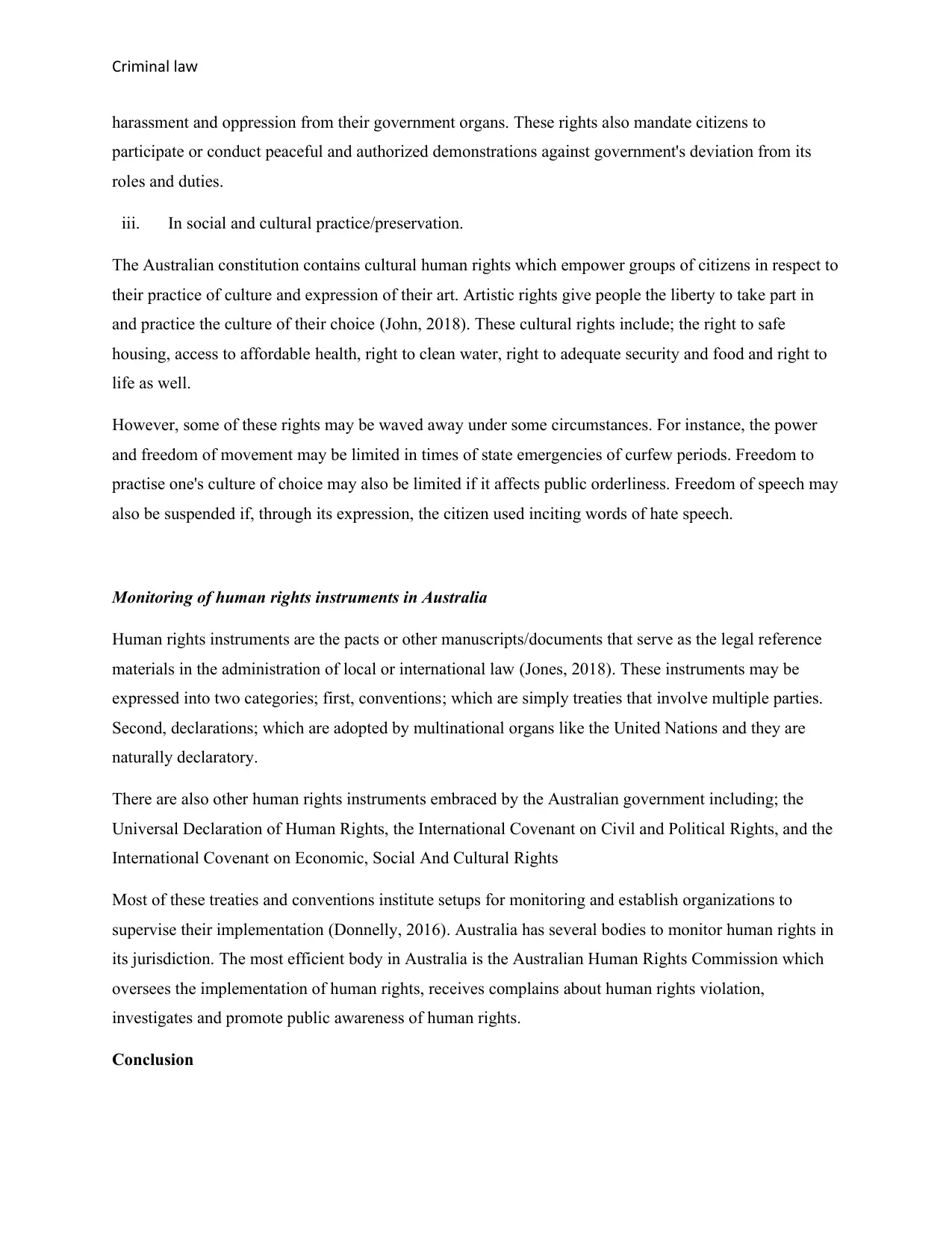
Cri inal lam w
harassment and oppression from their government organs. These rights also mandate citizens to
participate or conduct peaceful and authorized demonstrations against government's deviation from its
roles and duties.
iii. In social and cultural practice/preservation.
The Australian constitution contains cultural human rights which empower groups of citizens in respect to
their practice of culture and expression of their art. Artistic rights give people the liberty to take part in
and practice the culture of their choice (John, 2018). These cultural rights include; the right to safe
housing, access to affordable health, right to clean water, right to adequate security and food and right to
life as well.
However, some of these rights may be waved away under some circumstances. For instance, the power
and freedom of movement may be limited in times of state emergencies of curfew periods. Freedom to
practise one's culture of choice may also be limited if it affects public orderliness. Freedom of speech may
also be suspended if, through its expression, the citizen used inciting words of hate speech.
Monitoring of human rights instruments in Australia
Human rights instruments are the pacts or other manuscripts/documents that serve as the legal reference
materials in the administration of local or international law (Jones, 2018). These instruments may be
expressed into two categories; first, conventions; which are simply treaties that involve multiple parties.
Second, declarations; which are adopted by multinational organs like the United Nations and they are
naturally declaratory.
There are also other human rights instruments embraced by the Australian government including; the
Universal Declaration of Human Rights, the International Covenant on Civil and Political Rights, and the
International Covenant on Economic, Social And Cultural Rights
Most of these treaties and conventions institute setups for monitoring and establish organizations to
supervise their implementation (Donnelly, 2016). Australia has several bodies to monitor human rights in
its jurisdiction. The most efficient body in Australia is the Australian Human Rights Commission which
oversees the implementation of human rights, receives complains about human rights violation,
investigates and promote public awareness of human rights.
Conclusion
harassment and oppression from their government organs. These rights also mandate citizens to
participate or conduct peaceful and authorized demonstrations against government's deviation from its
roles and duties.
iii. In social and cultural practice/preservation.
The Australian constitution contains cultural human rights which empower groups of citizens in respect to
their practice of culture and expression of their art. Artistic rights give people the liberty to take part in
and practice the culture of their choice (John, 2018). These cultural rights include; the right to safe
housing, access to affordable health, right to clean water, right to adequate security and food and right to
life as well.
However, some of these rights may be waved away under some circumstances. For instance, the power
and freedom of movement may be limited in times of state emergencies of curfew periods. Freedom to
practise one's culture of choice may also be limited if it affects public orderliness. Freedom of speech may
also be suspended if, through its expression, the citizen used inciting words of hate speech.
Monitoring of human rights instruments in Australia
Human rights instruments are the pacts or other manuscripts/documents that serve as the legal reference
materials in the administration of local or international law (Jones, 2018). These instruments may be
expressed into two categories; first, conventions; which are simply treaties that involve multiple parties.
Second, declarations; which are adopted by multinational organs like the United Nations and they are
naturally declaratory.
There are also other human rights instruments embraced by the Australian government including; the
Universal Declaration of Human Rights, the International Covenant on Civil and Political Rights, and the
International Covenant on Economic, Social And Cultural Rights
Most of these treaties and conventions institute setups for monitoring and establish organizations to
supervise their implementation (Donnelly, 2016). Australia has several bodies to monitor human rights in
its jurisdiction. The most efficient body in Australia is the Australian Human Rights Commission which
oversees the implementation of human rights, receives complains about human rights violation,
investigates and promote public awareness of human rights.
Conclusion
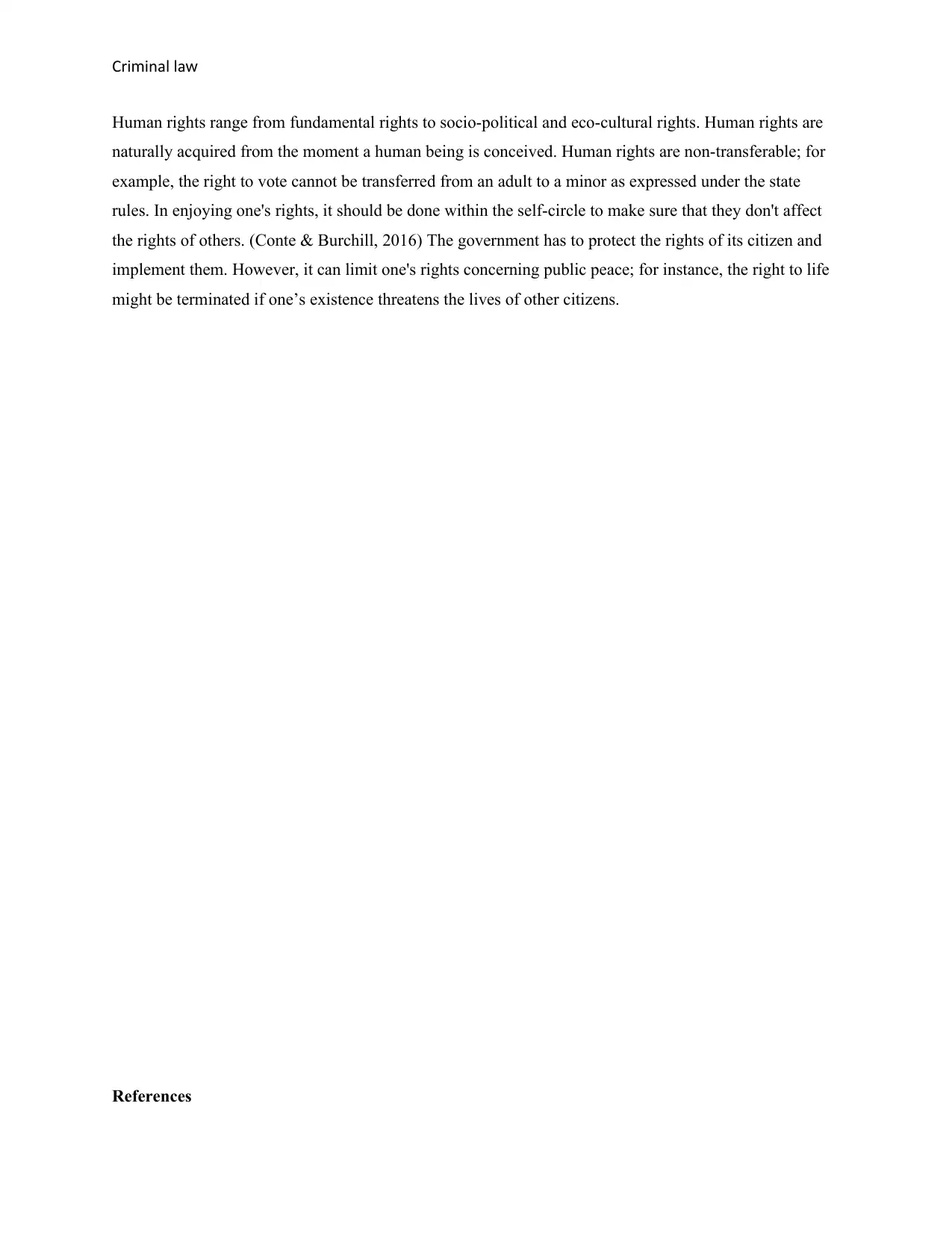
Cri inal lam w
Human rights range from fundamental rights to socio-political and eco-cultural rights. Human rights are
naturally acquired from the moment a human being is conceived. Human rights are non-transferable; for
example, the right to vote cannot be transferred from an adult to a minor as expressed under the state
rules. In enjoying one's rights, it should be done within the self-circle to make sure that they don't affect
the rights of others. (Conte & Burchill, 2016) The government has to protect the rights of its citizen and
implement them. However, it can limit one's rights concerning public peace; for instance, the right to life
might be terminated if one’s existence threatens the lives of other citizens.
References
Human rights range from fundamental rights to socio-political and eco-cultural rights. Human rights are
naturally acquired from the moment a human being is conceived. Human rights are non-transferable; for
example, the right to vote cannot be transferred from an adult to a minor as expressed under the state
rules. In enjoying one's rights, it should be done within the self-circle to make sure that they don't affect
the rights of others. (Conte & Burchill, 2016) The government has to protect the rights of its citizen and
implement them. However, it can limit one's rights concerning public peace; for instance, the right to life
might be terminated if one’s existence threatens the lives of other citizens.
References
Secure Best Marks with AI Grader
Need help grading? Try our AI Grader for instant feedback on your assignments.
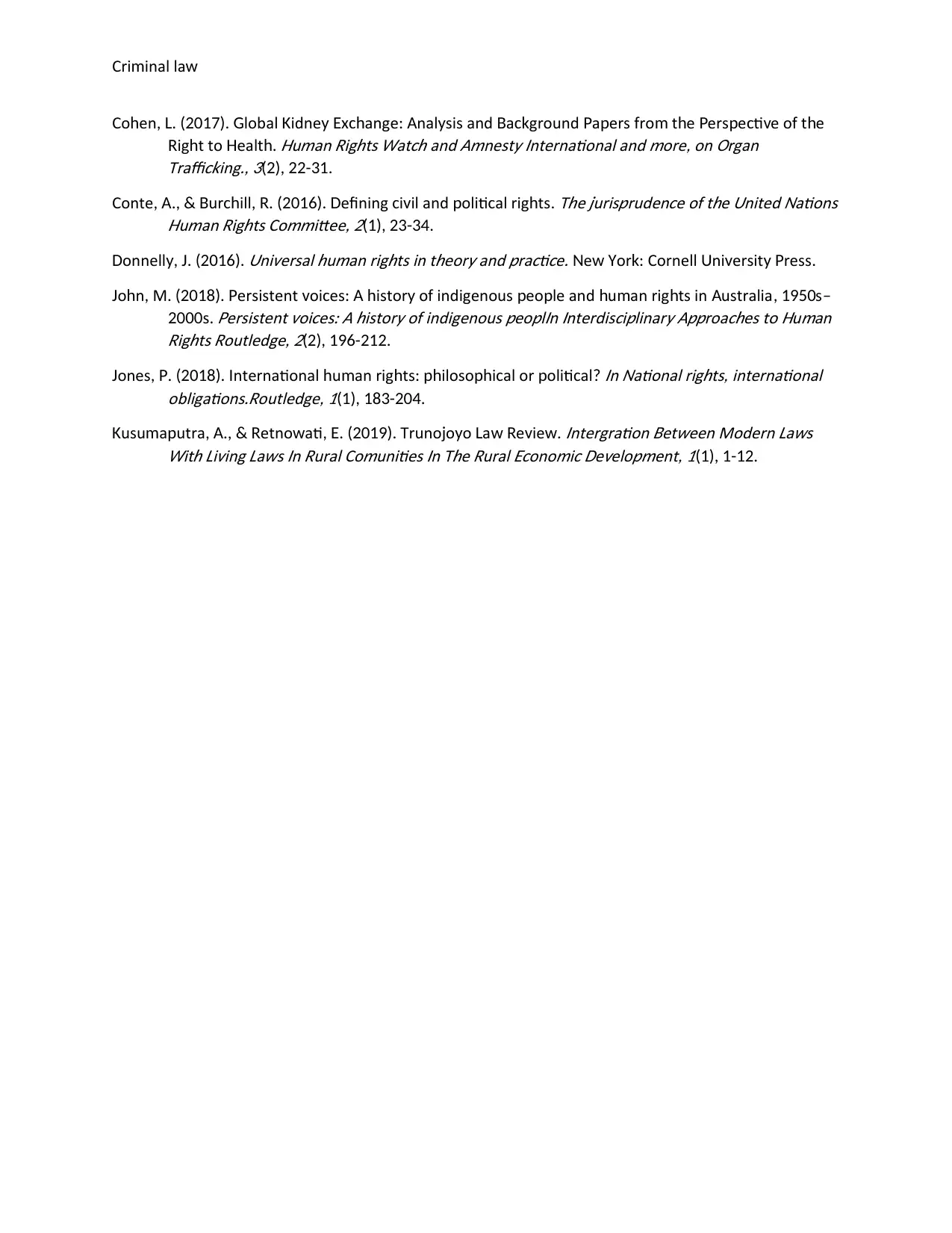
Cri inal lam w
Co en lobal idne ange nal sis and a ground a ers fro t e ers e ti e of t eh , L. (2017). G K y Exch : A y B ck P p m h P p c v h
ig t to ealtR h H h.
u an ig ts at and nest nternational and ore on rgan
H m R h W ch Am y I
m , O
Traffi ing
ck ., 3(2), 22-31.
Conte ur ill efining i il and oliti al rig ts, A., & B ch , R. (2016). D c v p c h .
T e uris ruden e of t e nited ations
h j p c h U N
u an ig ts Co ittee
H m R h mm , 2(1), 23-34.
onnellD y, J. (2016).
ni ersal u an rig ts in t eor and ra ti e
U v h m h h y p c c . e or Cornell ni ersit ressN w Y k: U v y P .
o n M ersistent oi es istor of indigenous eo le and u an rig ts in ustralia sJ h , . (2018). P v c : A h y p p h m h A , 1950 –
s2000 .
ersistent oi es istor of indigenous eo l n nterdis i linar roa es to u an
P v c : A h y
p p I I c p y App ch H m
ig ts outledge
R h R , 2(2), 196-212.
ones nternational u an rig ts iloso i al or oliti alJ , P. (2018). I h m h : ph ph c p c ?
n ational rig ts international
I N
h ,
obligations outledge
.R , 1(1), 183-204.
usu a utra etno ati Truno o o a e ieK m p , A., & R w , E. (2019). j y L w R v w.
ntergration et een Modern a s
I
B w
L w
it i ing a s n ural Co unities n T e ural ono i e elo ent
W h L v L w I R m I h R Ec m c D v pm , 1(1), 1-12.
Co en lobal idne ange nal sis and a ground a ers fro t e ers e ti e of t eh , L. (2017). G K y Exch : A y B ck P p m h P p c v h
ig t to ealtR h H h.
u an ig ts at and nest nternational and ore on rgan
H m R h W ch Am y I
m , O
Traffi ing
ck ., 3(2), 22-31.
Conte ur ill efining i il and oliti al rig ts, A., & B ch , R. (2016). D c v p c h .
T e uris ruden e of t e nited ations
h j p c h U N
u an ig ts Co ittee
H m R h mm , 2(1), 23-34.
onnellD y, J. (2016).
ni ersal u an rig ts in t eor and ra ti e
U v h m h h y p c c . e or Cornell ni ersit ressN w Y k: U v y P .
o n M ersistent oi es istor of indigenous eo le and u an rig ts in ustralia sJ h , . (2018). P v c : A h y p p h m h A , 1950 –
s2000 .
ersistent oi es istor of indigenous eo l n nterdis i linar roa es to u an
P v c : A h y
p p I I c p y App ch H m
ig ts outledge
R h R , 2(2), 196-212.
ones nternational u an rig ts iloso i al or oliti alJ , P. (2018). I h m h : ph ph c p c ?
n ational rig ts international
I N
h ,
obligations outledge
.R , 1(1), 183-204.
usu a utra etno ati Truno o o a e ieK m p , A., & R w , E. (2019). j y L w R v w.
ntergration et een Modern a s
I
B w
L w
it i ing a s n ural Co unities n T e ural ono i e elo ent
W h L v L w I R m I h R Ec m c D v pm , 1(1), 1-12.
1 out of 5
Related Documents
Your All-in-One AI-Powered Toolkit for Academic Success.
+13062052269
info@desklib.com
Available 24*7 on WhatsApp / Email
![[object Object]](/_next/static/media/star-bottom.7253800d.svg)
Unlock your academic potential
© 2024 | Zucol Services PVT LTD | All rights reserved.





